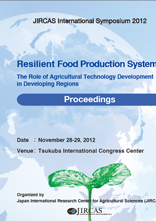Building Resilient Food Systems: Policies and Technologies

Nearly 870 million people suffer from hunger today and more than two billion suffer from micronutrient
deficiencies, according to the Food and Agriculture Organization (FAO) and World Health Organization
(WHO) of United Nations. Further, the IFPRI 2012 Global Hunger Index1 shows that over 50 countries
have levels of hunger that are “extremely alarming,” “alarming,” or “serious”?a large proportion of
which are in Asia and Africa south of the Sahara.
On top of these challenges, global and Asian food and nutrition security is further threatened by
emerging factors. Spikes in food prices, such as those seen during the 2007-2008 crisis, undermine the
ability of poor and vulnerable groups in developing countries to purchase the food commodities they
depend on for their primary daily caloric intake. Weather and climate-related shocks, including reduced
rainfall and heat spells, put pressure on already scare resources and limited capacity of smallholders. Poor
crop management, such as post-harvest waste and crop deterioration due to pests and disease, further
compromises smallholder productivity and inhibits the ability of low-income countries to improve food
security domestically.
In addition to a brief overview of challenges to global and Asian food security as well as the importance
of recognizing the interfaces between policies, technologies, the environment, and food security, this
presentation will outline key actions central to such an innovative and integrated approach, including:
? Investing in agriculture and technological innovations to boost productivity and stability of crops and
animals, especially smallholder productivity; enhance the nutritional value of food crops; and increase
resource-use efficiency.
? Establishing more productive and better targeted social safety measures, such as public works
programs or cash or food transfers, to cushion the poor against shocks in the short run and improve
productivity in the long run through access to credit, extension, and technology.
? Investing in climate change mitigation/adaptation and promoting low-carbon agriculture through
“triple win” solutions which increase the adaptive capacity of farmers, promote GHG mitigation, and
boost productivity.
? Increasing global coordination to reduce food price volatility including establishing strategic emergency
food reserves; ensuring open trade; and eliminating grain-based biofuel production.
? Developing innovative insurance and financing instruments which encourage farmers to take
productivity-enhancing risks, such as adopting new technologies and high-value crops. Examples include
weather-based index insurance, futures contracts, and guarantee funds.
| Date of issued | |
|---|---|
| Creator | Shenggen Fan |
| Subject |
Global food and nutrition security agricultural development innovative and integrated approach |
| Publisher | Japan International Research Center for Agricultural Sciences |
| Available Online | |
| Issue | 2012 |
| spage | 12 |
| epage | 26 |
| Rights | Japan International Research Center for Agricultural Sciences |
| Language | eng |
